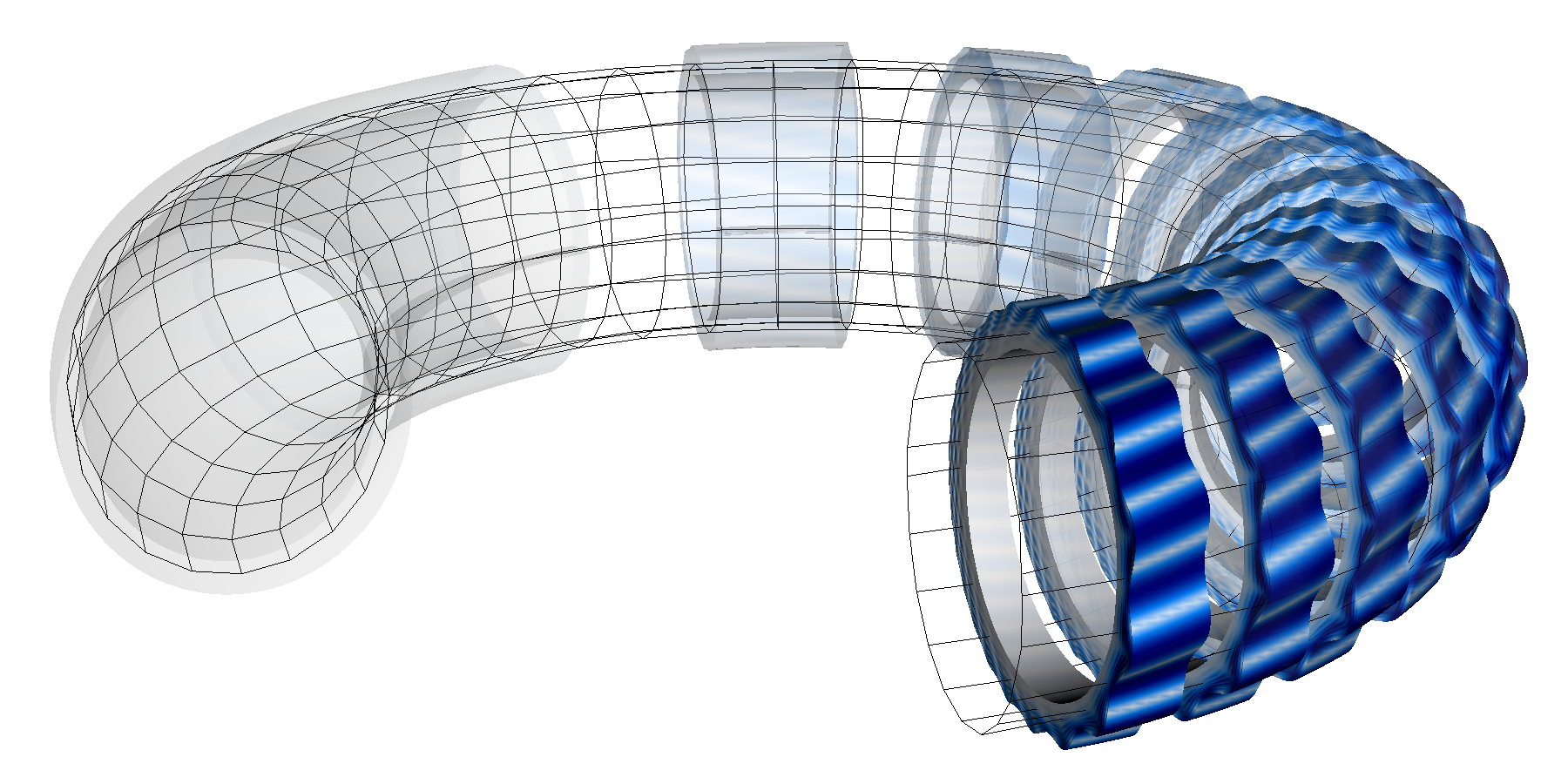 ["Artistic rendering" of a typical ballooning mode in the cylindrical test case CBM18. Shown by the color code is the absolute value of the most destabilizing perpendicular displacement, on the perturbed geometry.]
["Artistic rendering" of a typical ballooning mode in the cylindrical test case CBM18. Shown by the color code is the absolute value of the most destabilizing perpendicular displacement, on the perturbed geometry.]
Be sure to check out the Doxygen documentation!
Peeling-Ballooning in 3-D
PB3D is a code written in Fortran to calculate the hign-n edge stability of 3-D equilibria using ideal linear MHD theory. High-n stability refers to normal modes that have a fast spatial dependence perpendicular to the magnetic fieldlines, and a slow variation like the equilibrium along them. Therefore, they are referred to often as fluted modes. Fluted modes have been shown to be important for the MHD stability of toroidal configurations as they are easily excited but can couple power from the hot core to the cold vessel walls. So-called peeling-ballooning modes, for example, have yielded a credible model for the behavior of ELMs, which are understood as a cycling between both instability types. Here it is important to correctly consider the influence of edge effects, as the plasma boundary can be perturbed, especially for peeling modes. A numerical code, ELITE [1], exists that considers that considers this for axisymmetric equilibria.
However, the importance of 3-D effects has to be investigated, as tokamaks do not have perfect axisymmetry, and stellarators are inherently 3-D. For tokamaks, for example, the use of RMPs through perturbaiton coils, that break axisymmetry deliberately, is considered to control the behavior of ELMs. Therefore, the theory of a full 3-D treatment with edge effects is presented in [2]. One of the conclusions is that for high-n perturbations, only modes that lie around the same field line are coupled, reducing the order of the stability problem. The numerical code PB3D (Peeling-Ballooning in 3-D) implements this theory and solves it for the configurations given by multiple equilibrium codes, such as VMEC and HELENA. When the equilibria are restricted to axisymmetry, the domain of validity of ELITE is recovered, but PB3D goes beyond that, allowing for arbitrary 3-D configurations. First verification with MISHKA and COBRA results are presented in [3].
Work is being done on the influence of a 3-D toroidal field ripple on the peeling-ballooning stability of the pedestal region in H-mode plasmas. This will be submitted for publication soon. ELM control through 3-D resonant perturbation fields will be considered in the near future.
If the PB3D project interests you, I am available for cooperations.—Please contact me weyenst@gmail.com—
This project is under construction. More information about running PB3D will be updated in the future.
External Libraries
In order not to reinvent the wheel, PB3D makes use of external libraries. Some of them are mentioned here:- Slepc is an advanced library for the solution of eigenvalue problems of various kinds, built on top of the sparse matrices linear algebra library Petsc. The user can change the solution algorithms very easily to take advantage of the newest advances in the field, without having to implement them. Slepc is also coupled to external packages to perform specific (sub)tasks, such as MUMPS.
- The pspline library is a fast and user-friendly implementation of spline interpolation.
- The MPI standard is used to parallelize PB3D.
- HDF5 is a flexible data model, library, and file format for storing and managing data. It is built on top of the MPI standard. In PB3D, it is used to produce output files as well as files for restart. The implementation is independent of the number of MPI processes used.
Toon Weyens
Postdoctoral Researcher
Confinement & Modelling Section
ITER Organization, Building 81/148, SCOD, Science Division
Route de Vinon-sur-Verdon - CS 90 046 - 13067 St Paul Lez Durance Cedex - France
Phone: +33 4 42 17 83 37
Google Scholar -
LinkedIn
References
[1] H. R. Wilson, P. B. Snyder, G. T.~A. Huysmans, R. L. Miller, Numerical studies of edge localized instabilities in tokamaks, Physics of Plasmas 9 (4) (2002) 1277, doi:10.1063/1.1459058
[2] T. Weyens, R. Sánchez, L. García, A. Loarte, G. T. A. Huysmans, Three-dimensional linear peeling-ballooning theory in magnetic fusion devices, Physics of Plasmas 21 (4) (2014) 042507, doi:10.1063/1.4871859
[3] T. Weyens, R. Sánchez, L. García, A. Loarte, G. T. A. Huysmans, PB3D: A new code for edge 3-D ideal linear peeling-ballooning stability, Journal of Computational Physics, doi:10.1016/j.jcp.2016.10.054